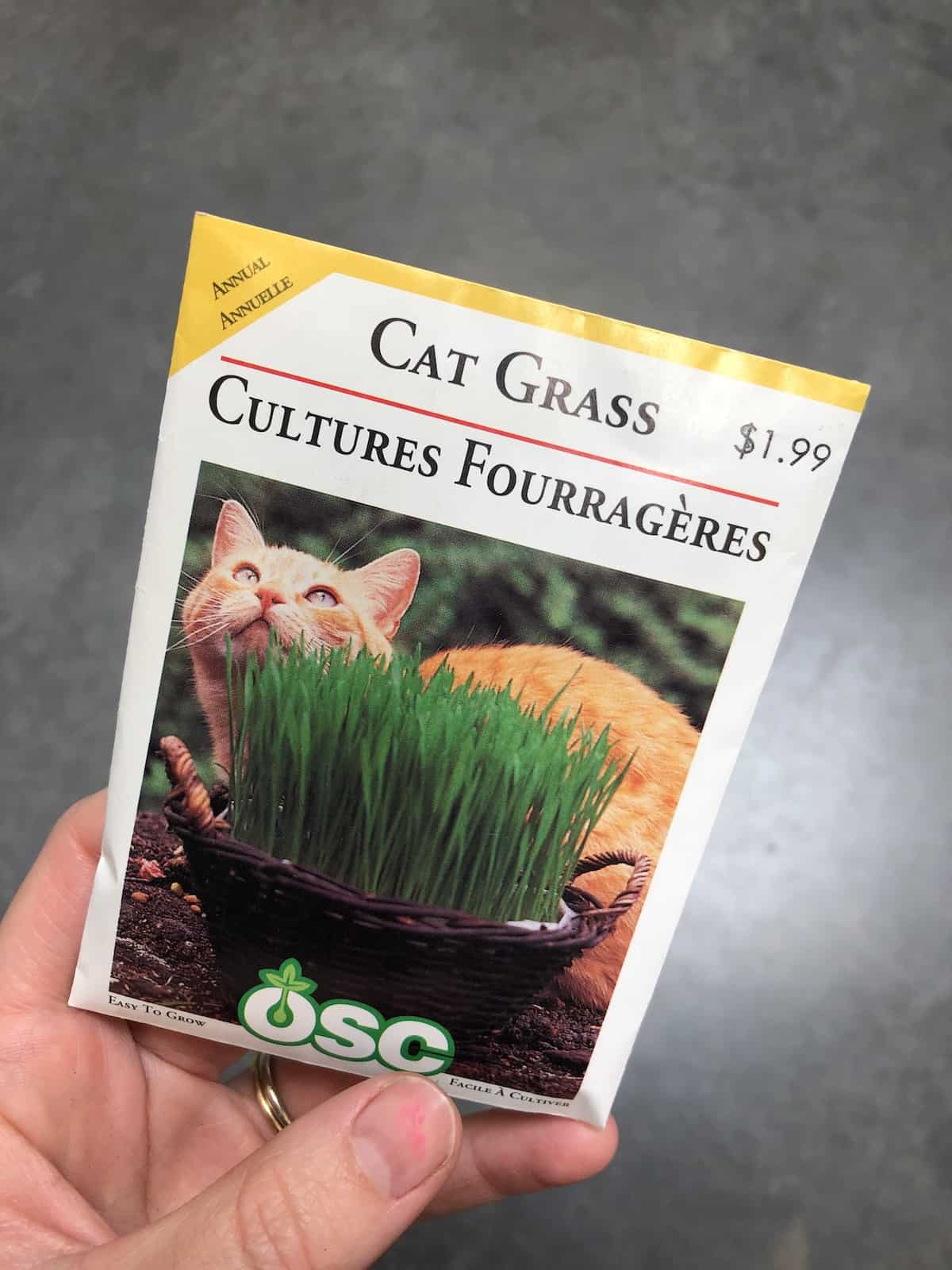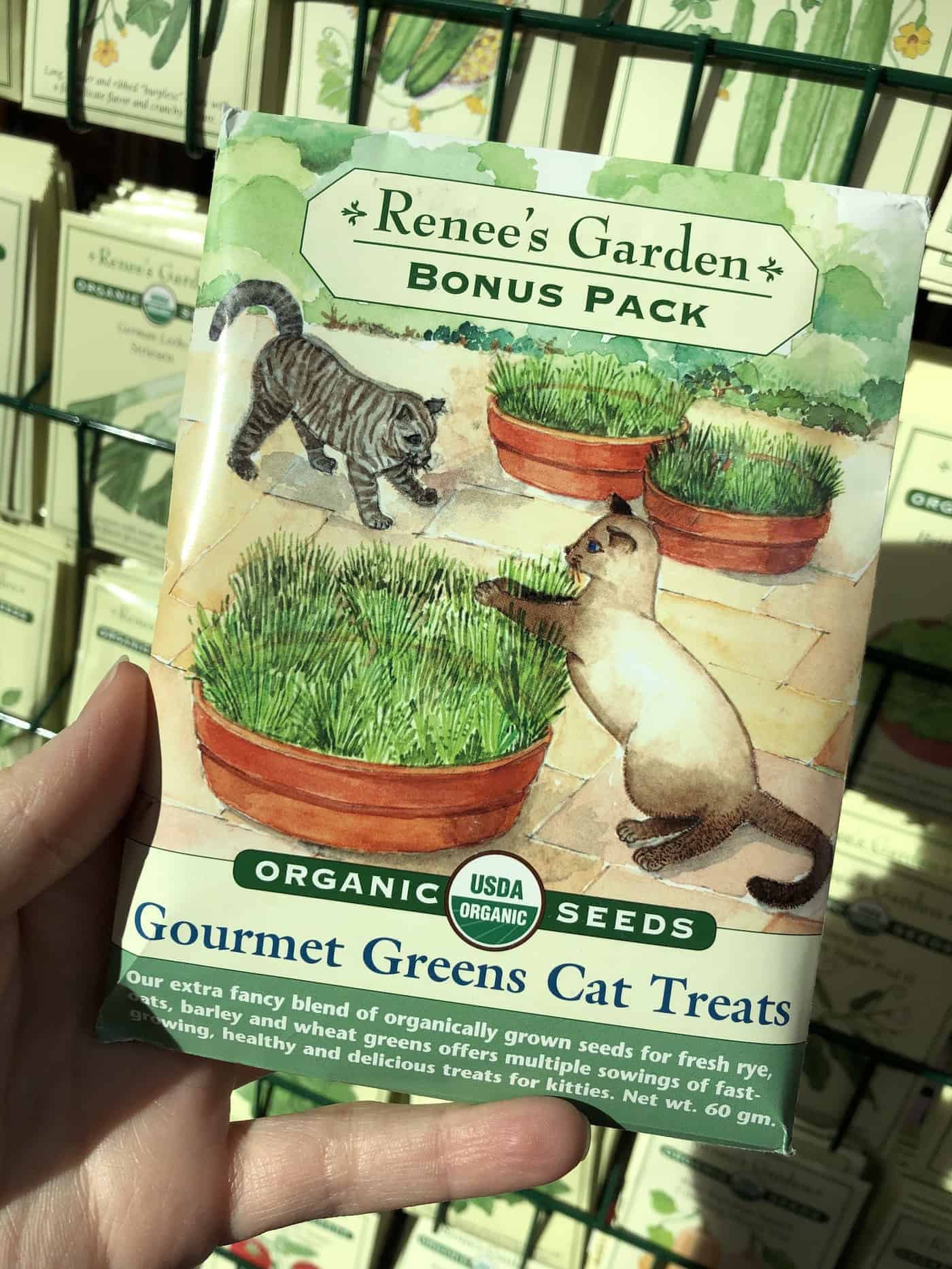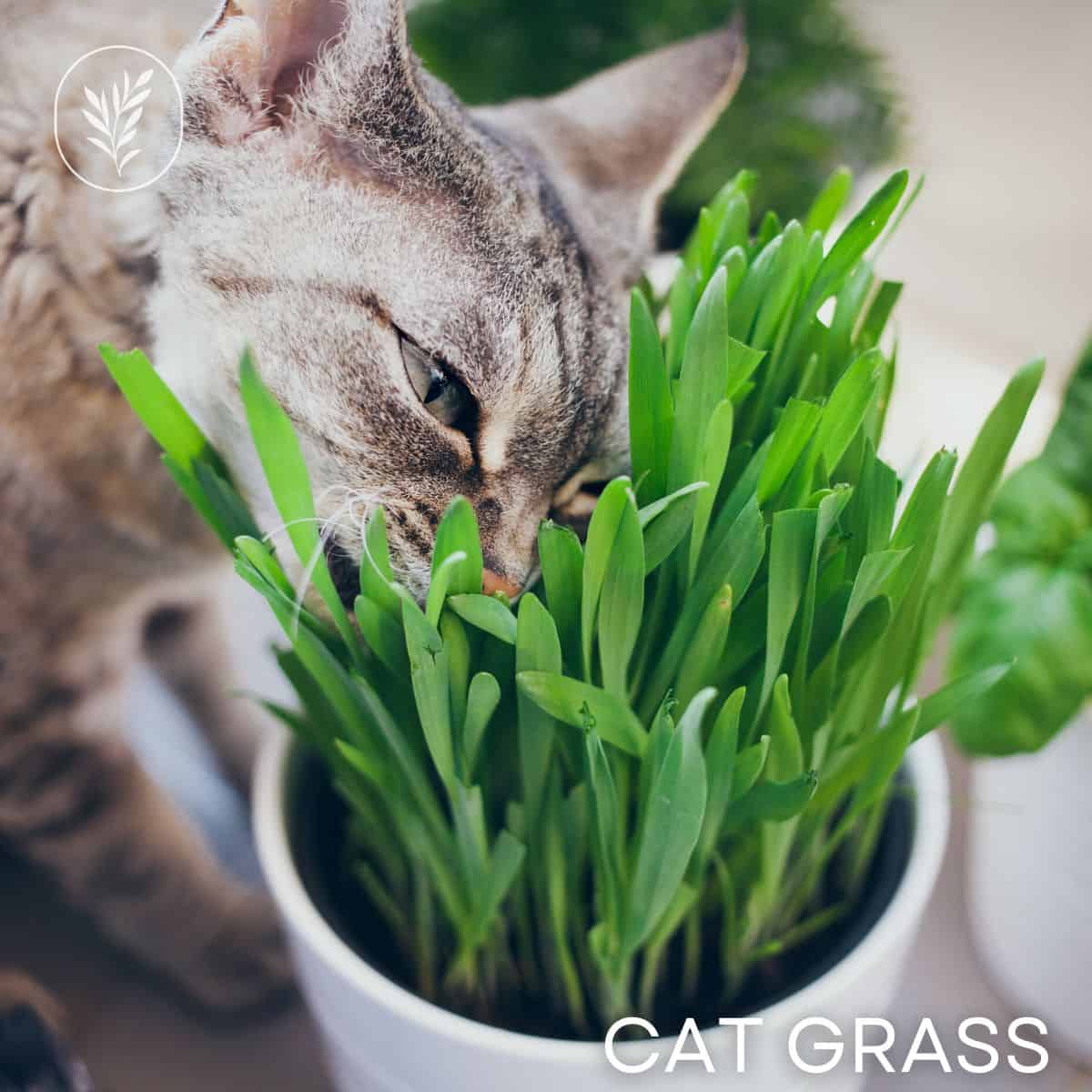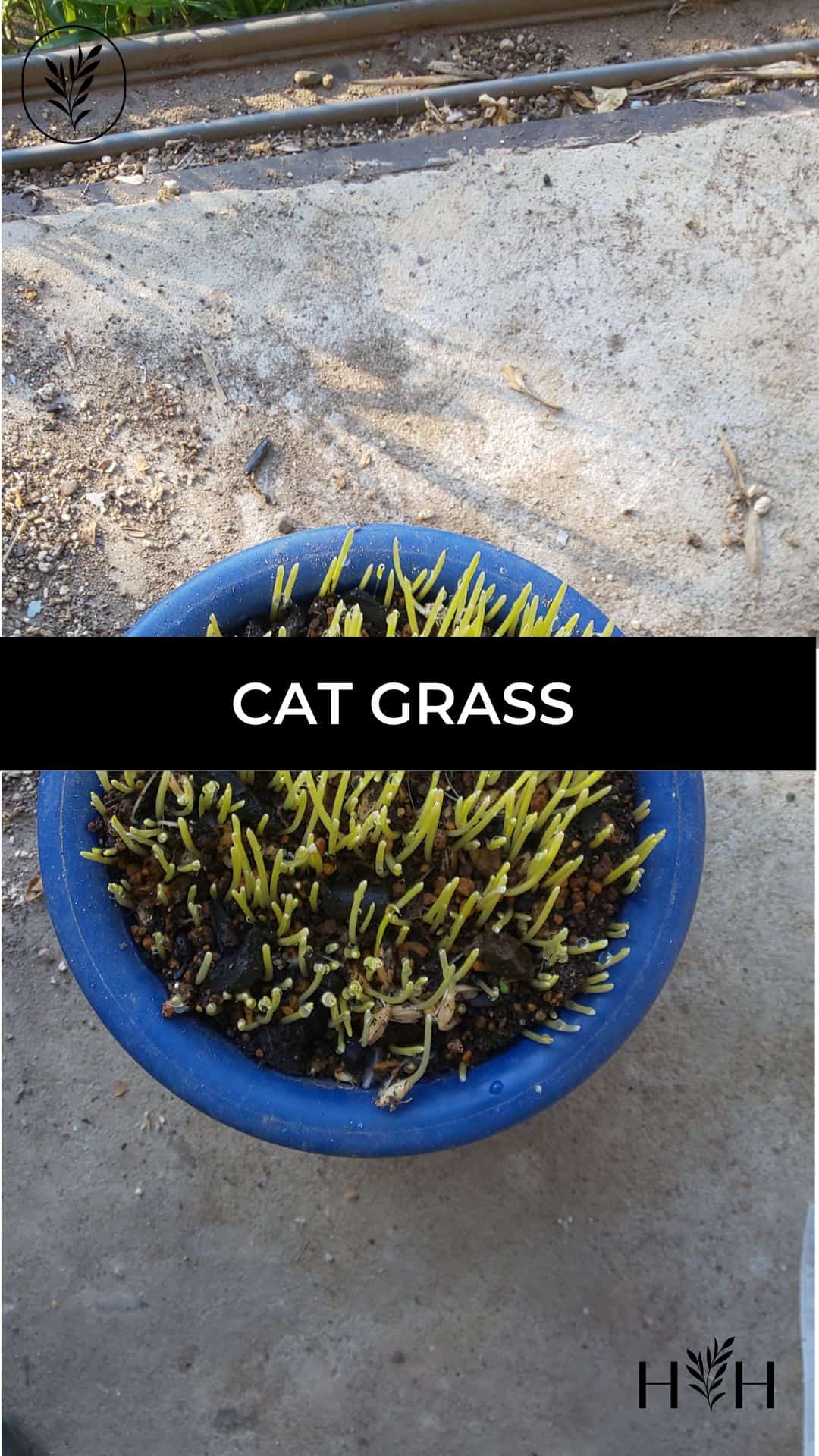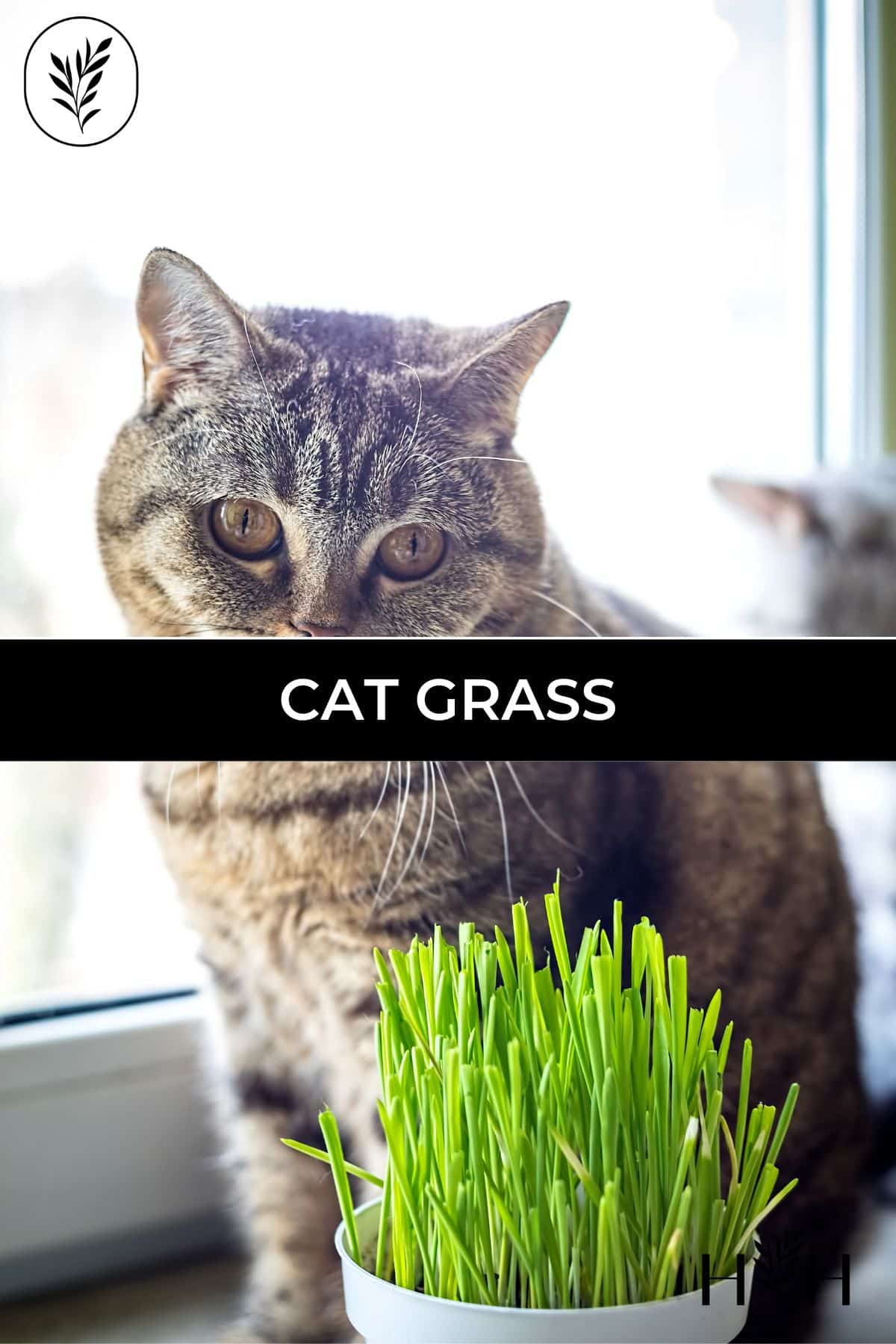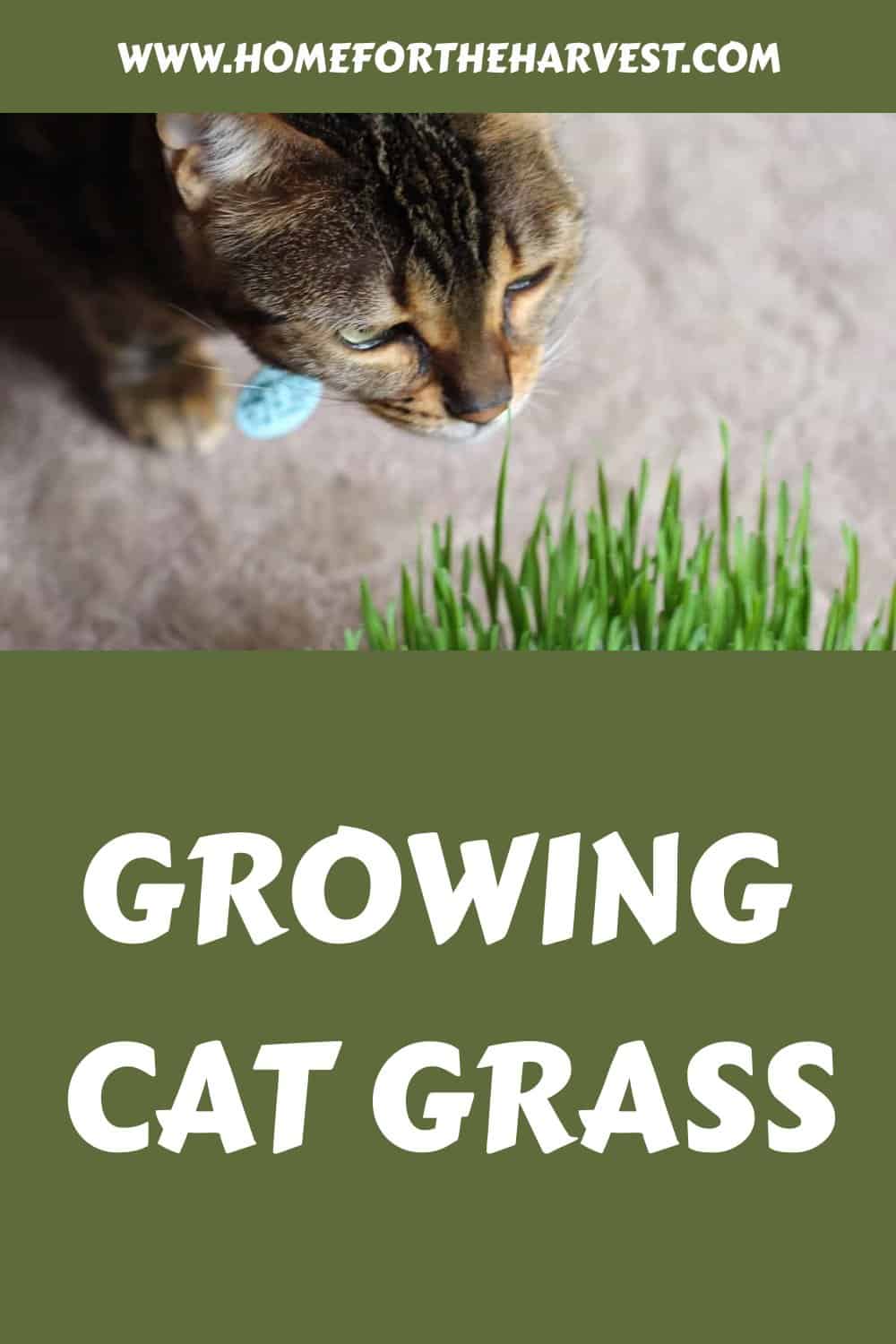If you’re a cat lover, ensuring a comfortable, healthy, and entertaining environment is the ultimate goal for your pet. If your cat is already spoiled with tons of toys and treats, cat grass is a fun and healthy item to add to your cat’s living environment!
Cat grass is the baby shoots of cereal grain plants grown indoors in a small tray. Cat grass is grown specifically for cats to enjoy, whether they simply play with it or nibble on it as well. Typically reaching a height of about 4″-6″, cat grass is usually grown from barley, wheat, rye, and/or oat seeds.
That said, what does growing cat grass entail? Well, read on to learn more about cat grass!
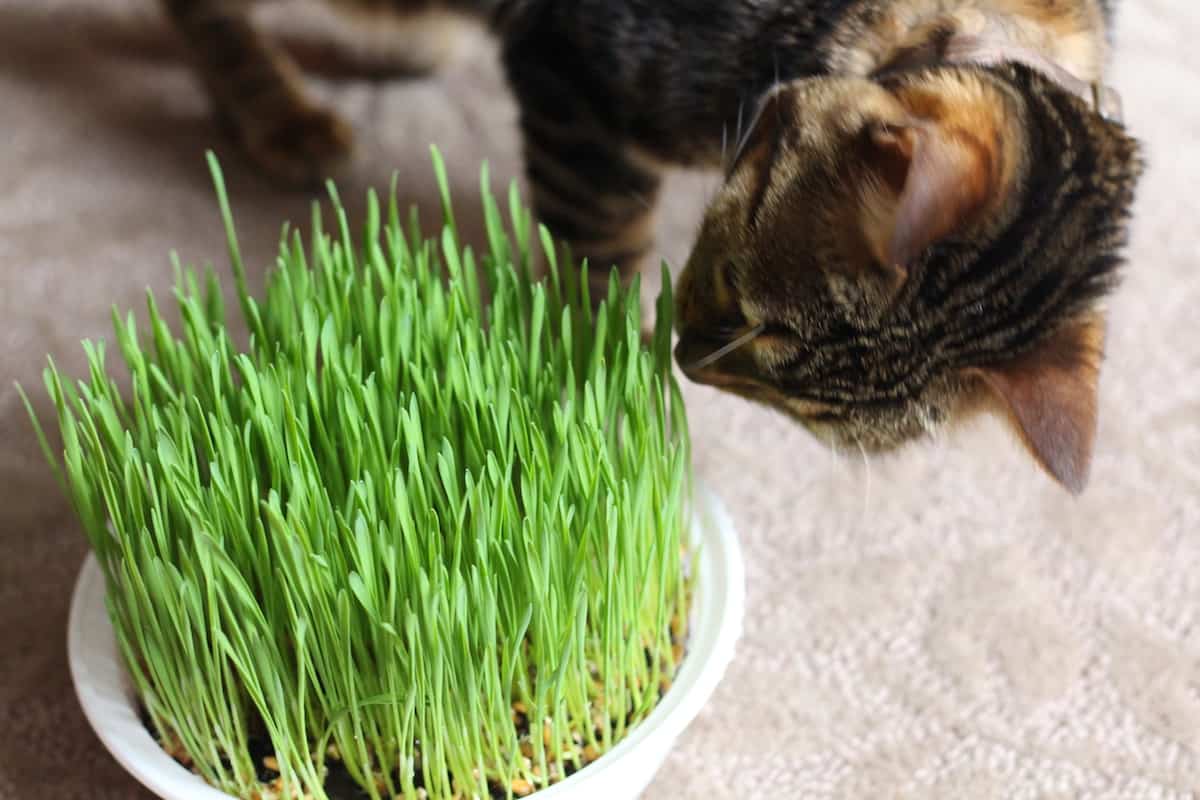
How to grow cat grass
It’s time to learn to grow some cat grass for your beloved kitty! Fortunately, it is very easy. Here are supplies and step-by-step instructions for growing cat grass at home.
Supplies for growing cat grass
- Cat Grass Seeds (generally annual wheat, oat, barley, or rye)
- Organic potting soil
- Shallow tray or repurposed container
- Strainer or small container
- Spray bottle or small watering vessel
- Tray lid or cling wrap (optional)
“Cat grass is good for your pet’s digestive system, especially if your cat is an indoors-only pet.”
Indoor Kitchen Gardening: Turn Your Home Into a Year-round Vegetable Garden, by Elizabeth Millard
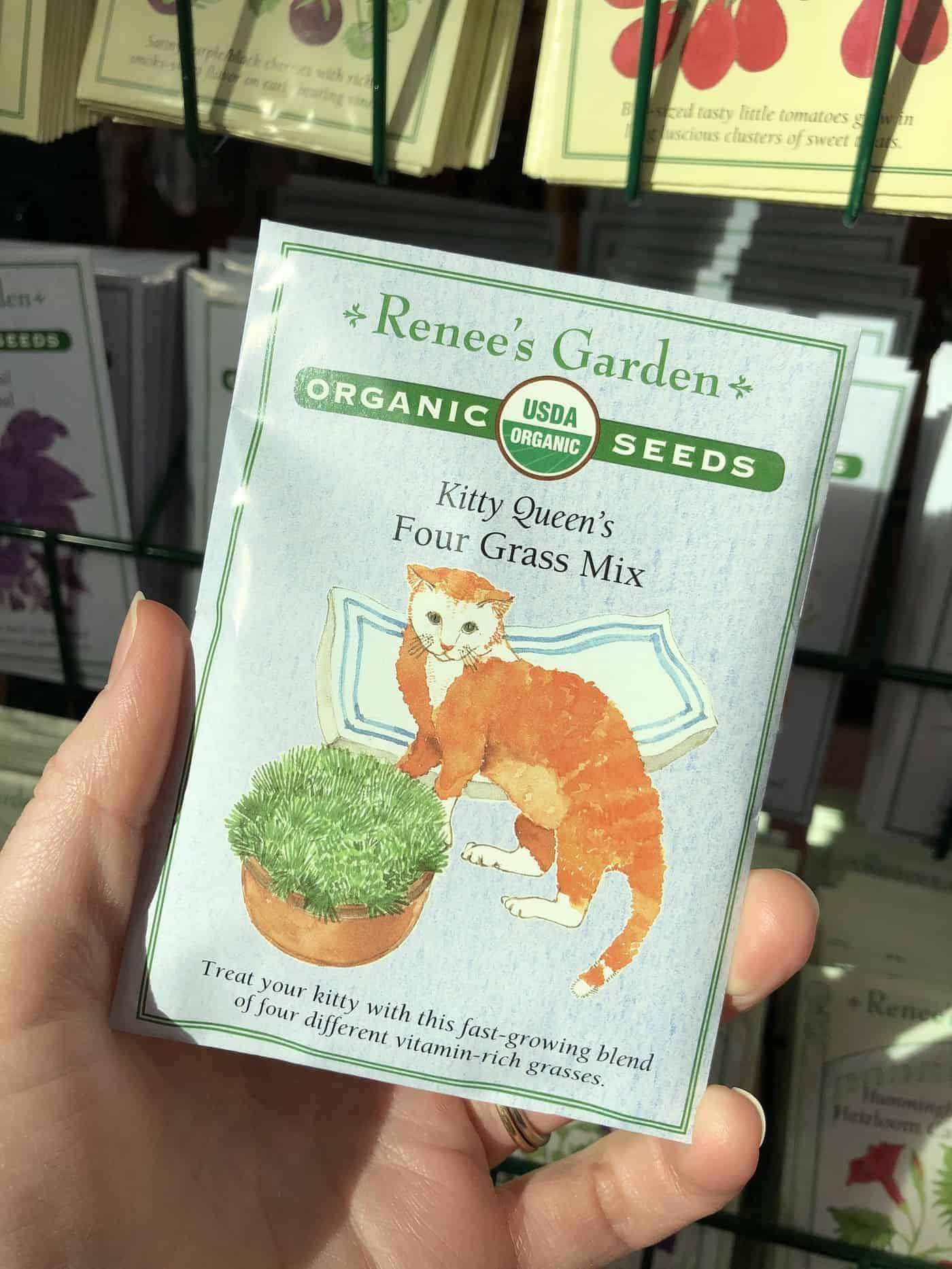
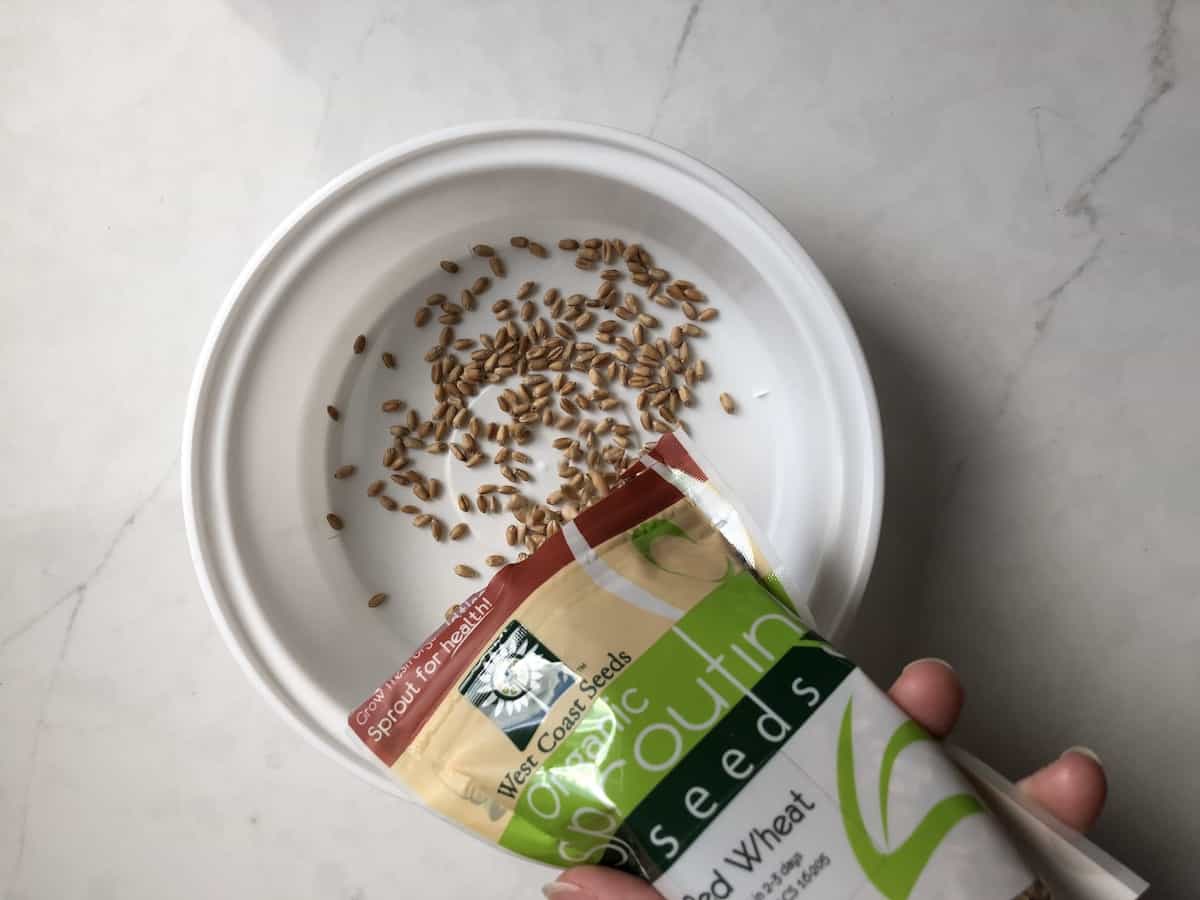
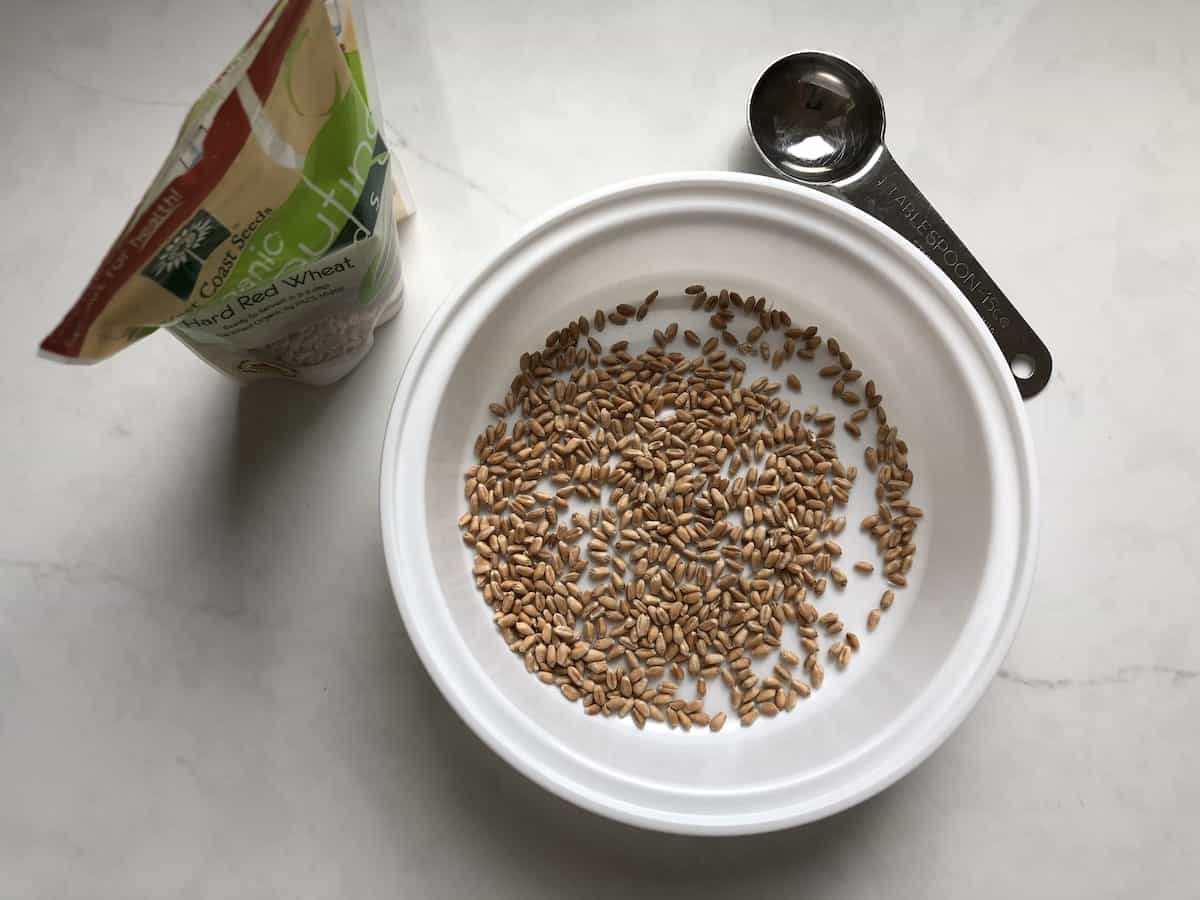
Step 1: Measure out the seeds
The first step is to measure an appropriate number of seeds for your tray. This is not an exact process. You can grow the seeds very sparsely or fill the whole area up. I like to use enough seeds so the grass is full and thick, but the roots and shoots still each have a bit of room. See the photo above, where I’ve decided on 2 Tbsp of dry wheat seeds (Hard Red Spring Wheat).
Most individual-sized take-out trays grow best with 1-2 Tbsp of dry seed. Jot down how many seeds you’ve used so you can make adjustments in the future if need be.
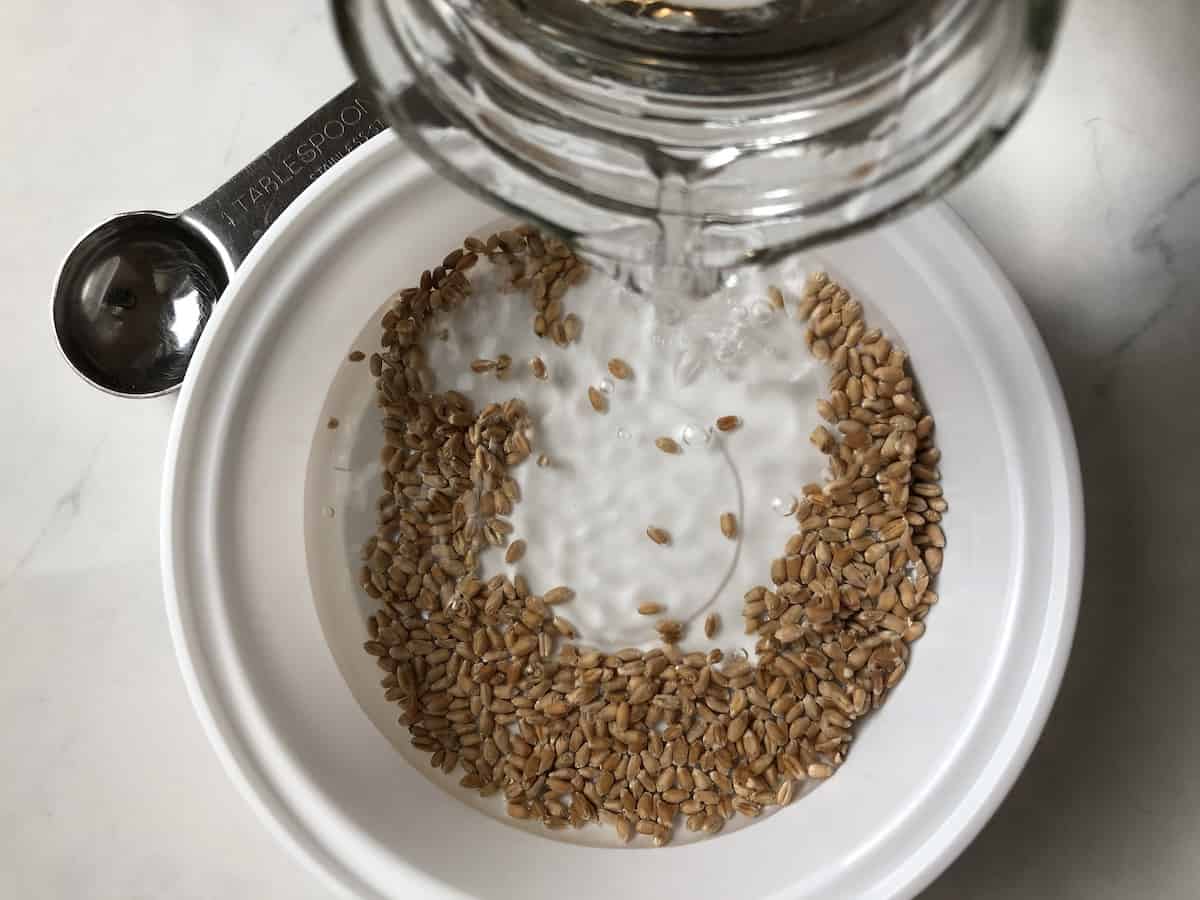
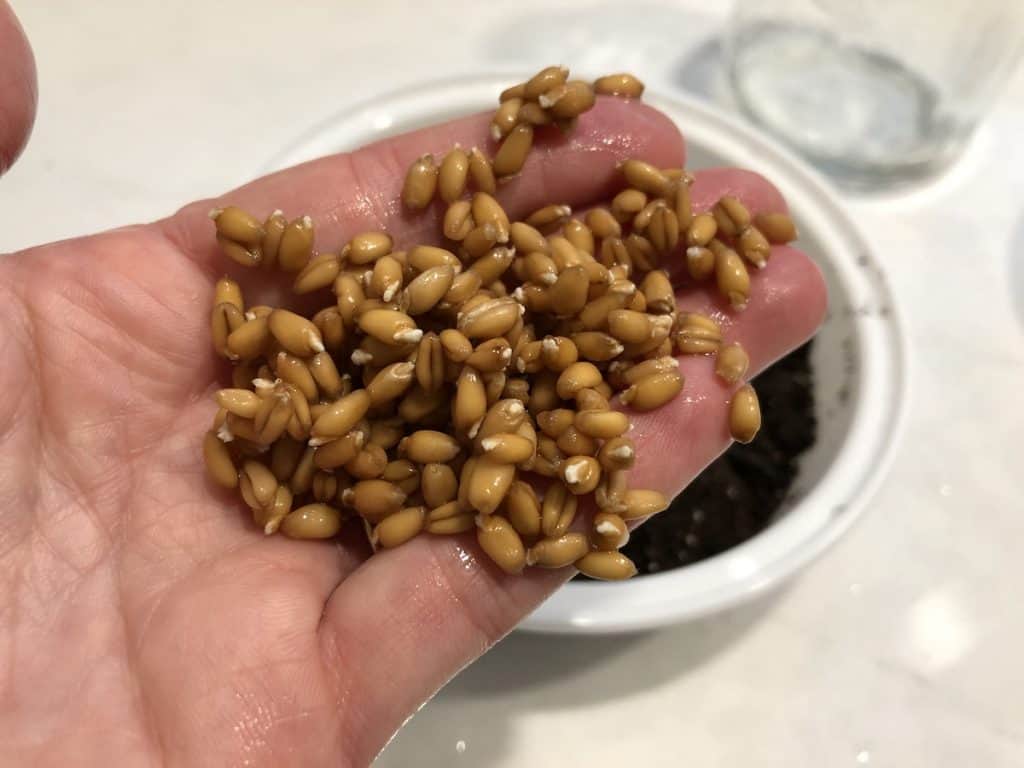
Step 2: Soak seeds in water
The next step is to pour some clean water into the tray with the seeds. Seeds for cat grass can be soaked for 6-8 hours (before planting them) to give them a kickstart on germination. Let the seeds sit submerged in the water so the moisture can soften the outer layer of the seeds and encourage sprouting.
While 6-8 hours of soaking time is probably a good target, I have had similar success with seeds soaked for only 4 hours and with seeds soaked for 12 hours in clean fresh water.
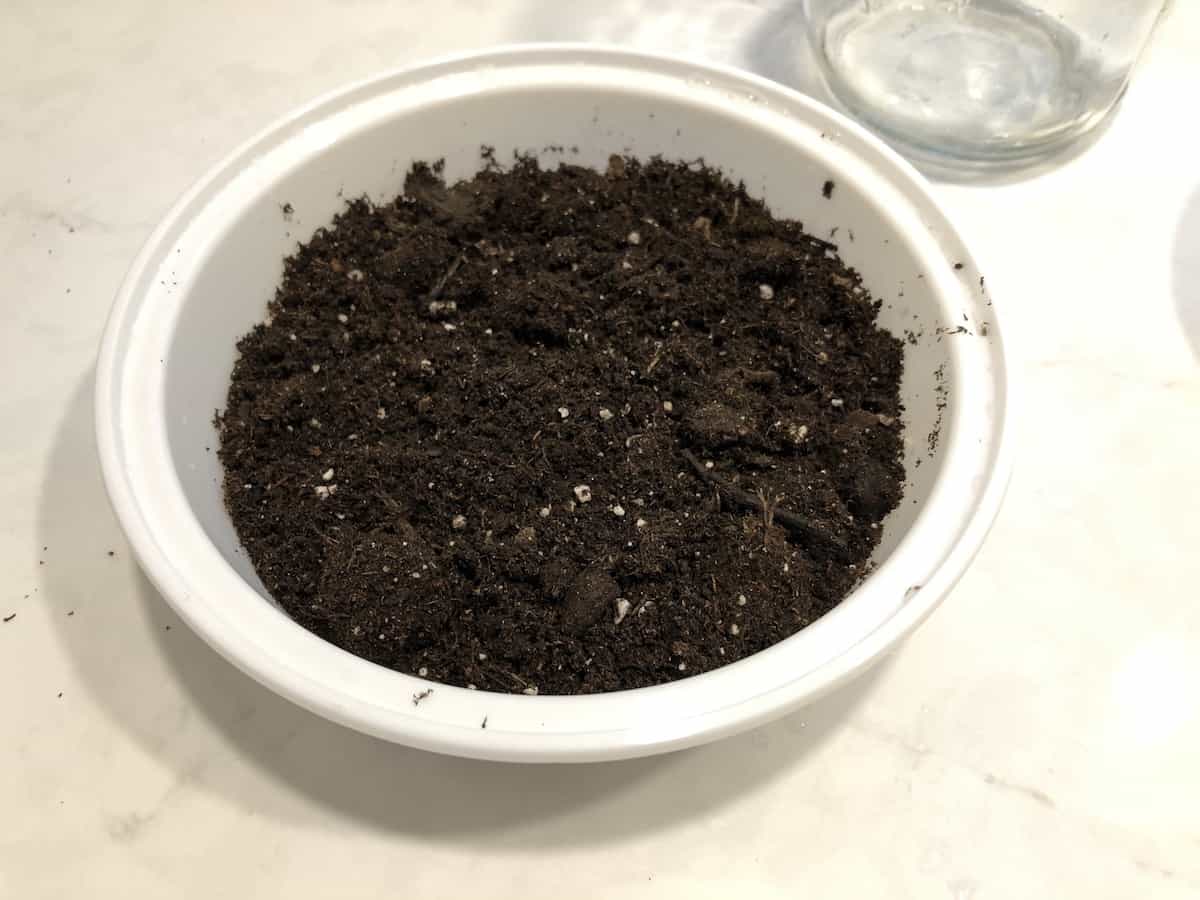
Step 3: Prep soil tray
Remove the seeds from the tray at this point so you can add the potting soil. I like to pour the seeds and water through a strainer in the sink and then use the sink tap to gently wash the soaking water off the seeds. Set aside seeds.
Fill the tray/container with a thin layer of potting soil. The amount of soil you use is mostly a matter of personal preference. You could put a few inches of depth into a particularly deep tray or use absolutely no potting soil at all (it’s finicky but totally doable). I used about a 1/2 inch (1 cm) depth of potting soil in the batch shown in the photos.
Use your spray bottle or water vessel to moisten the potting soil. The goal is for the soil to be damp, but not wet like a mud puddle. Imagine it as a sponge that has been placed under the tap of water and then wrung out. Like the sponge, your soil should contain some moisture, but also pockets of air. The roots of cat grass need immediate access to both air and water!
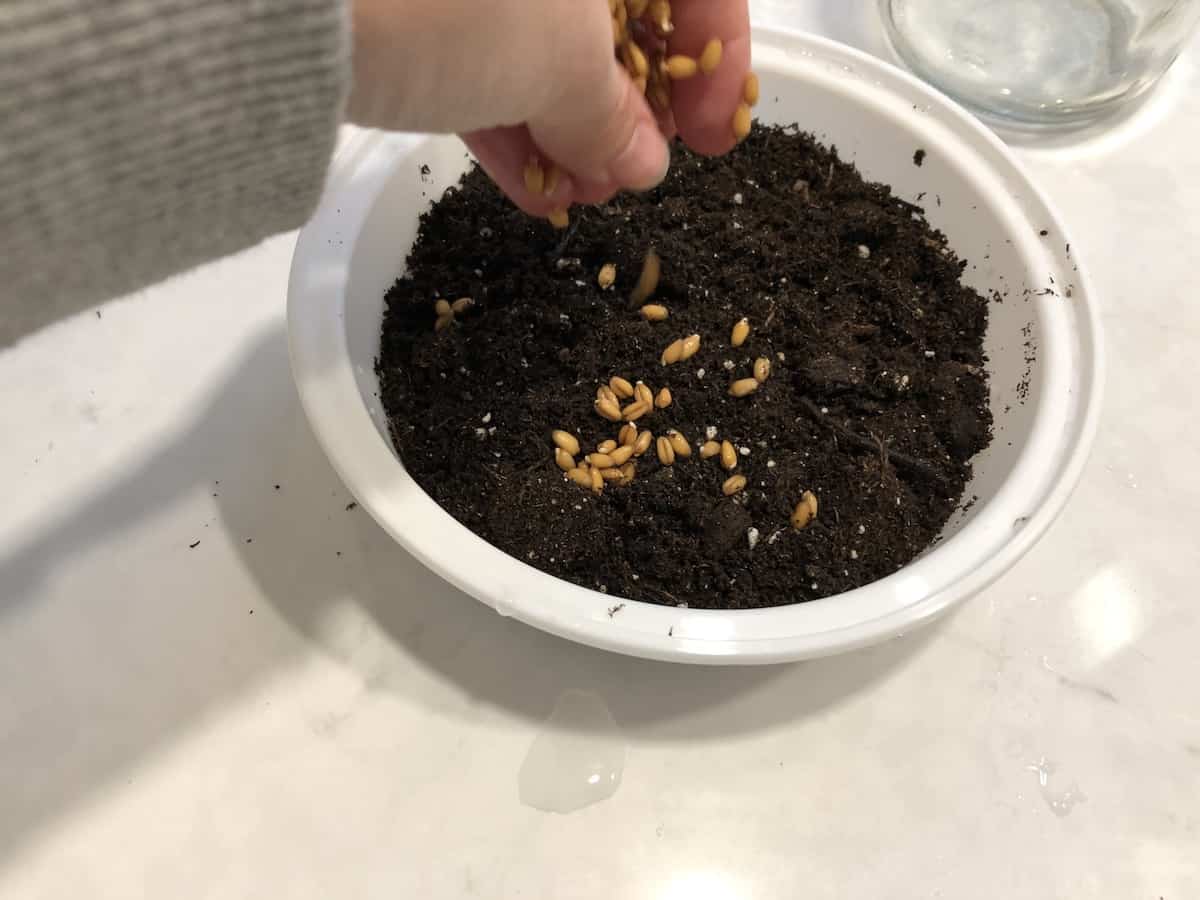
Step 4: Plant cat grass seeds
Now that the seeds have been soaked and washed, they’re ready to be planted. Gently transfer the damp seeds from the strainer onto the surface of the soil. The seeds need to be treated with care at this point as they have delicate, tiny little buds that are the beginnings of all future growth. Be gentle with them!
Sprinkle the seeds on the soil by hand and carefully move them around if there are too many in one spot. Coverage will never be perfectly even, but it doesn’t have to be for the full-grown grass to look full and thick.
If you like, you can gently push the seeds down into the soil, but they’ll also grow perfectly well while sitting on top of the soil. In the batch pictured below, some of the seeds are mixed in with the dirt while some of them are sitting on top of the potting soil. And that’s just fine.
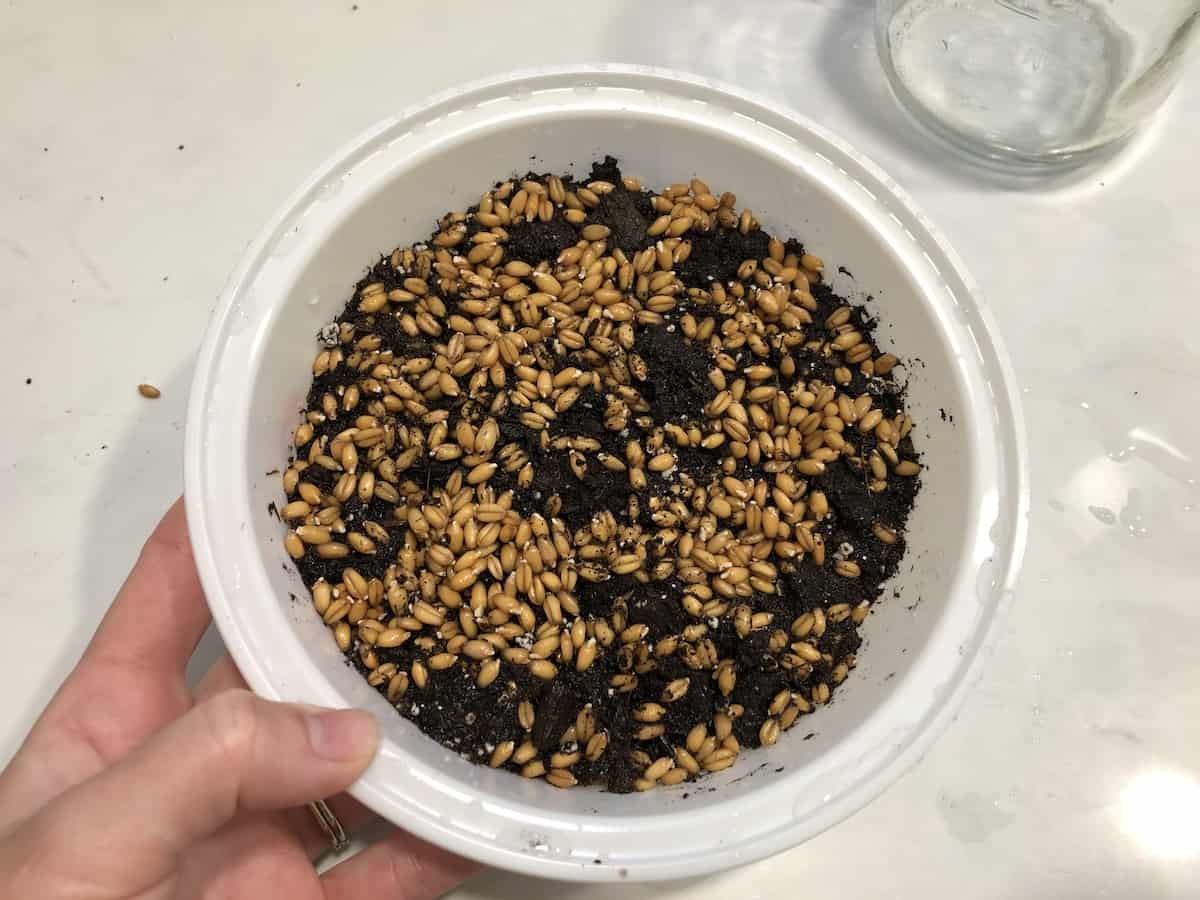
Step 5: Water, cover, and set aside
Now that the seeds are planted, make any final adjustments like shifting the seeds around or adding a bit more water (or pouring off some water if there is too much).
At this point, the cat grass is off to a great start. Some cat lovers like to cover the tray at this point to create a mini-greenhouse for the seeds. You can use a tray cover, cling wrap, or repurposed plastic bag. Or you can just leave the tray open to the air. Either way, you’ll be checking on the tray each morning and evening.
Find a warm, sunny spot to serve as your cat grass growing station. A well-insulated sunny windowsill works well, and light can always be improved with a mini plant light. We’re looking for somewhere cozy and bright with good air circulation.
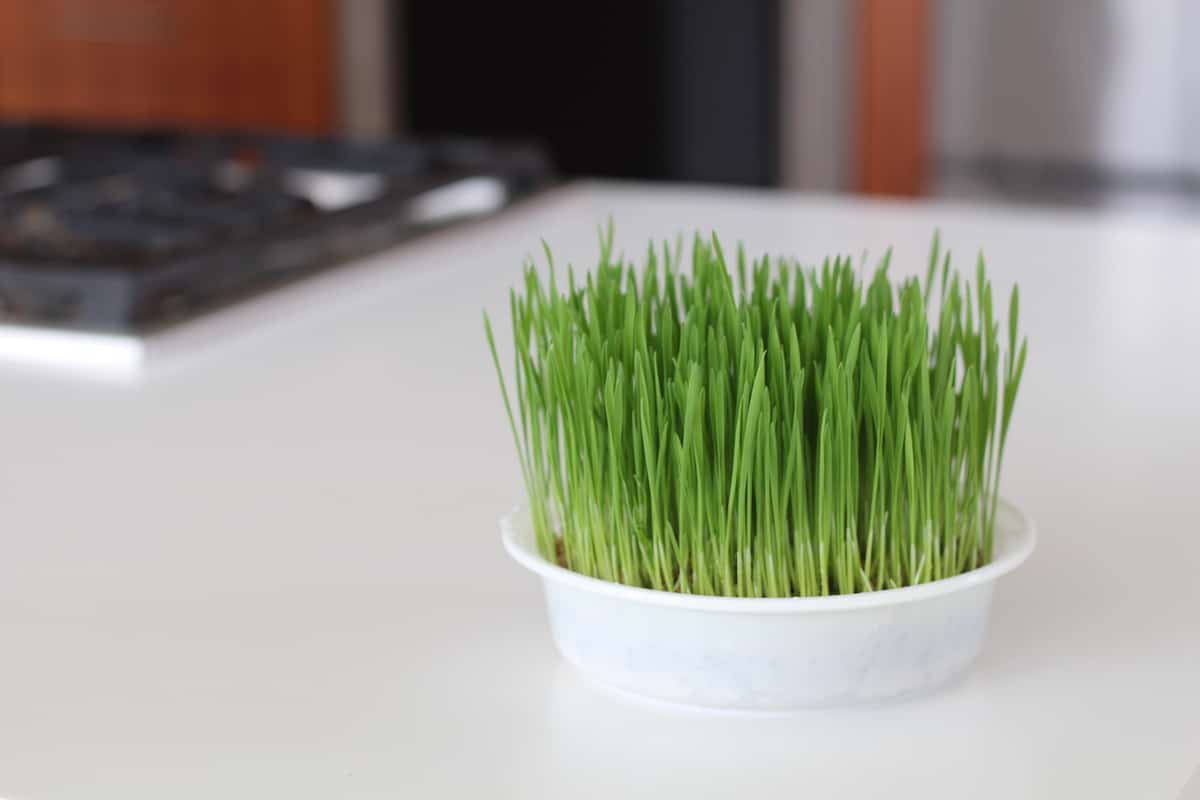
Step 6: Check cat grass twice per day
Whether you’ve covered your tray or not, check it twice per day (generally in the morning and in the evening). The idea is to make sure the tiny roots have access to both air and water.
The tray shouldn’t feel too light or too heavy. The soil shouldn’t be dry and it shouldn’t be muddy. Somewhere in the middle is best.
Trays that aren’t covered or are in really dry homes may need quite a bit of water added to them every 12 hours. Try not to let the soil and seeds dry out completely.
Covered trays or trays grown in more humid spots may only need a bit of water every day or two. In these environments, good air circulation is critical. Even if the tray doesn’t require watering, take off the cover or move it to a breezy spot for a bit to ensure the baby plants have access to fresh air.
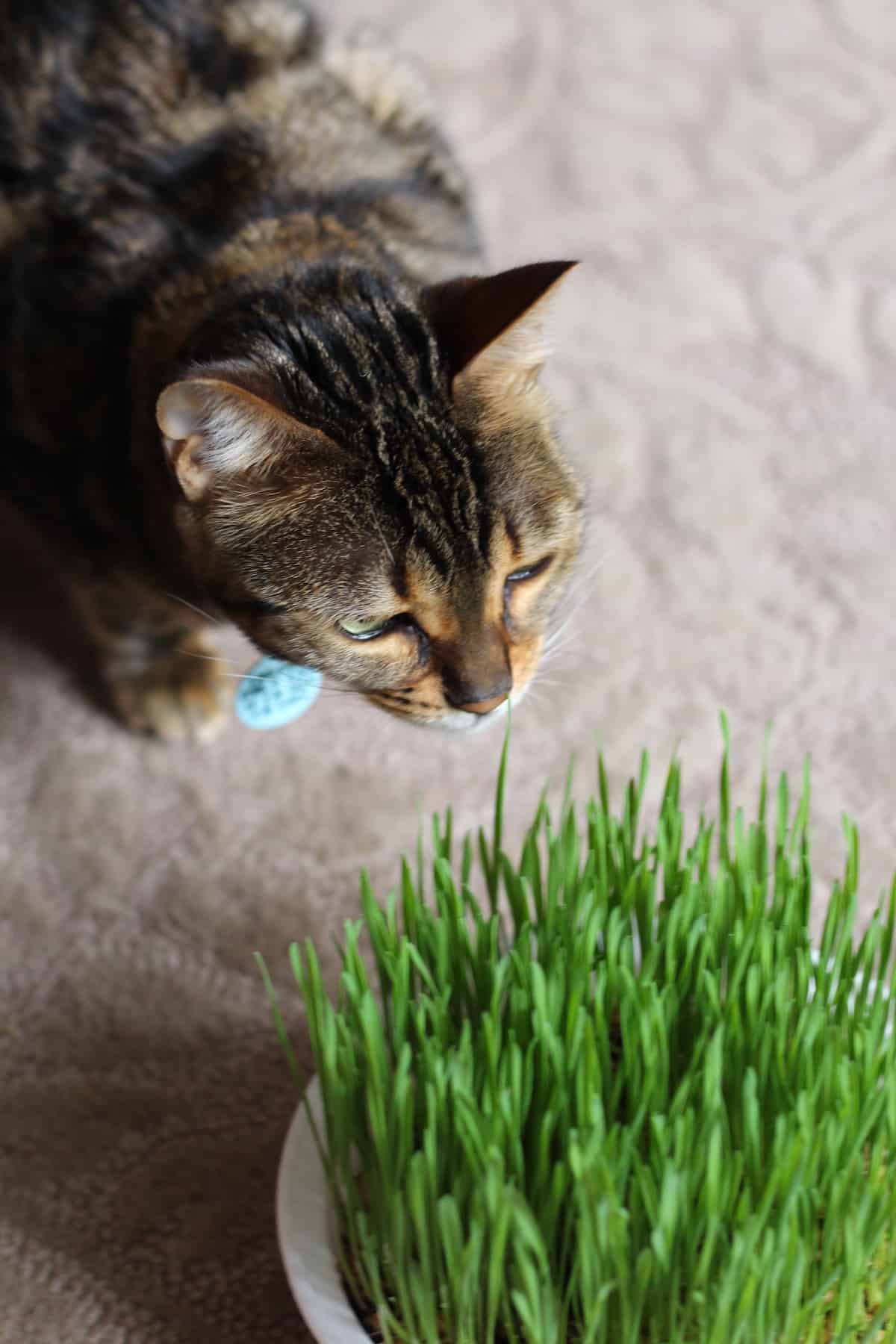
Step 7: Give cat grass to the cat & start the next tray
The cat grass generally grows a tiny bit each day for the first few days, and then really shoots up towards the end of the week. Cat grass can grow tall enough to use in as little as 5 days in optimal conditions, while it might take two weeks in sub-par environments. A week is a great rule-of-thumb for time to harvest cat grass.
Most cat owners tend to plant one tray of cat grass each week per cat. For instance, Sunday might be your cat grass day. Every Sunday, you’ll soak the seeds for 6-8 hours, making sure they’re planted before you go to bed in the evening. Then kitty will have a fresh tray to enjoy during each subsequent weekend.
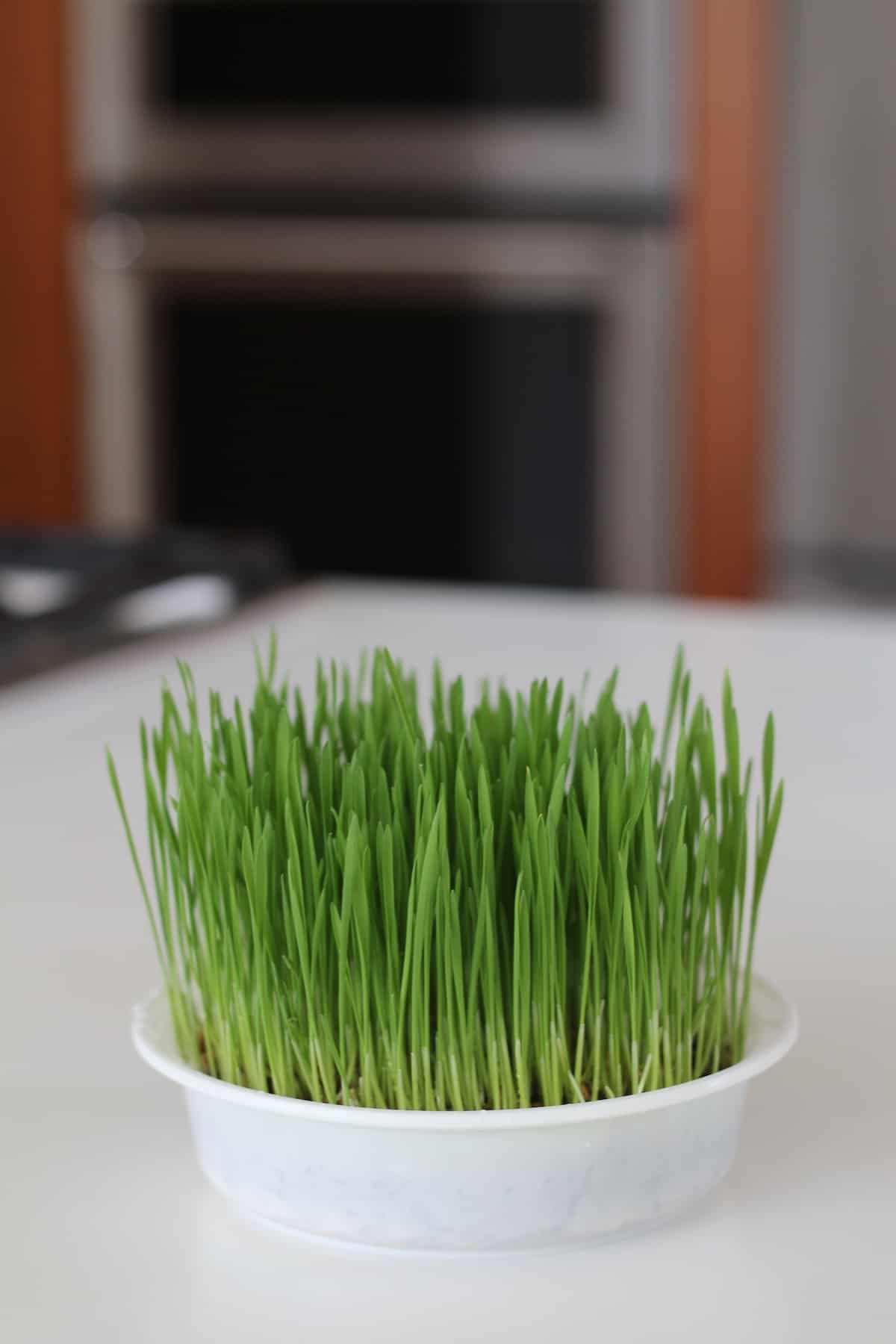
What is cat grass?
Cat grass is annual cereal grass (or a mix of grasses) grown indoors in a small tray specifically for cats to enjoy. Typically grown to a height of about 4″-6″, cat grass is usually grown from barley, wheat, rye, and/or oat seeds. You can even grow regular wheatgrass for cats.
Cat grass is most commonly grown organically, without any synthetic fertilizer or pesticides. A tray of cat grass takes about a week to grow. A single tray of cat grass can live for 2-4 weeks, depending on the inputs from both the growing environment and the cat enjoying it.
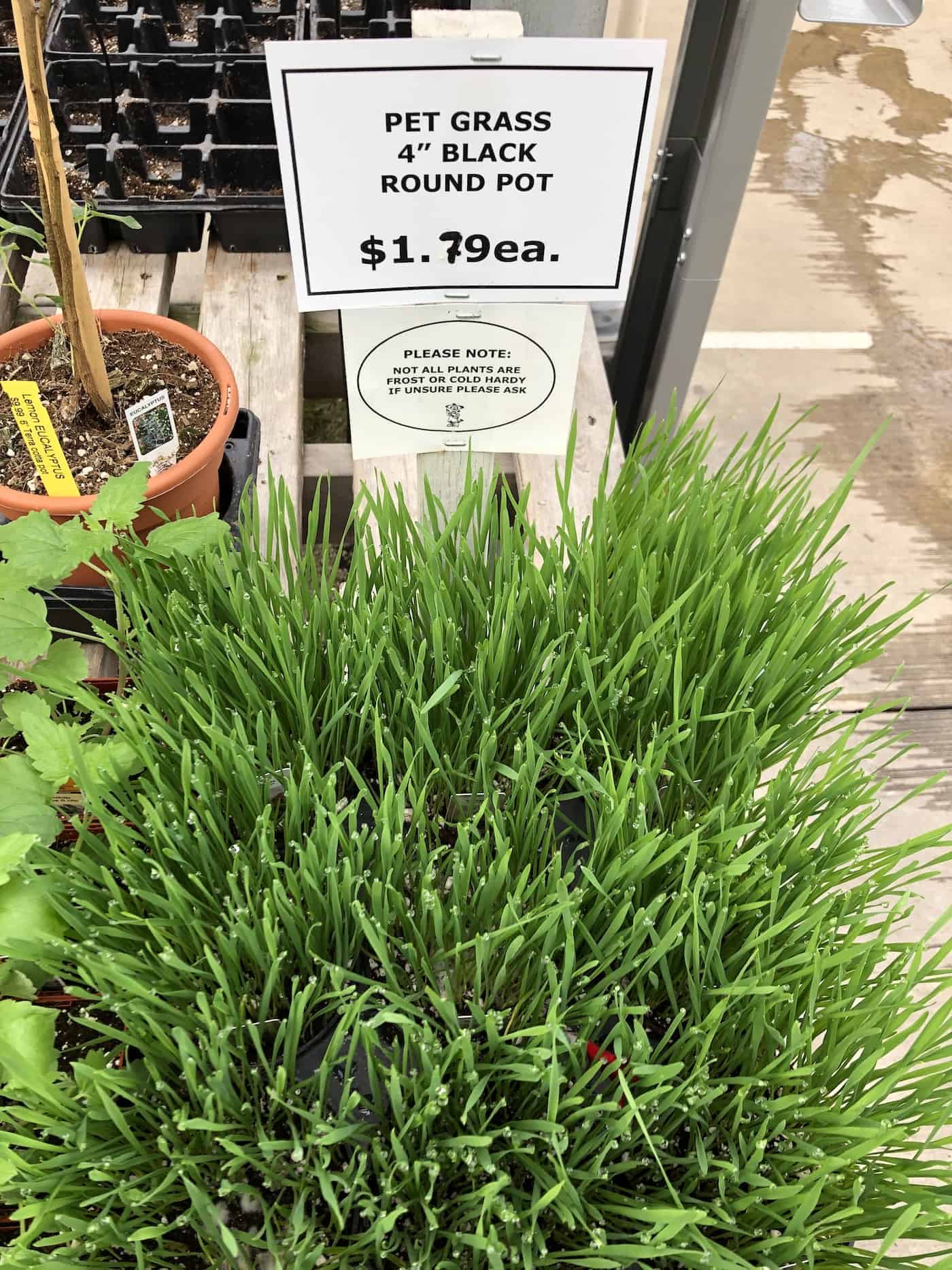
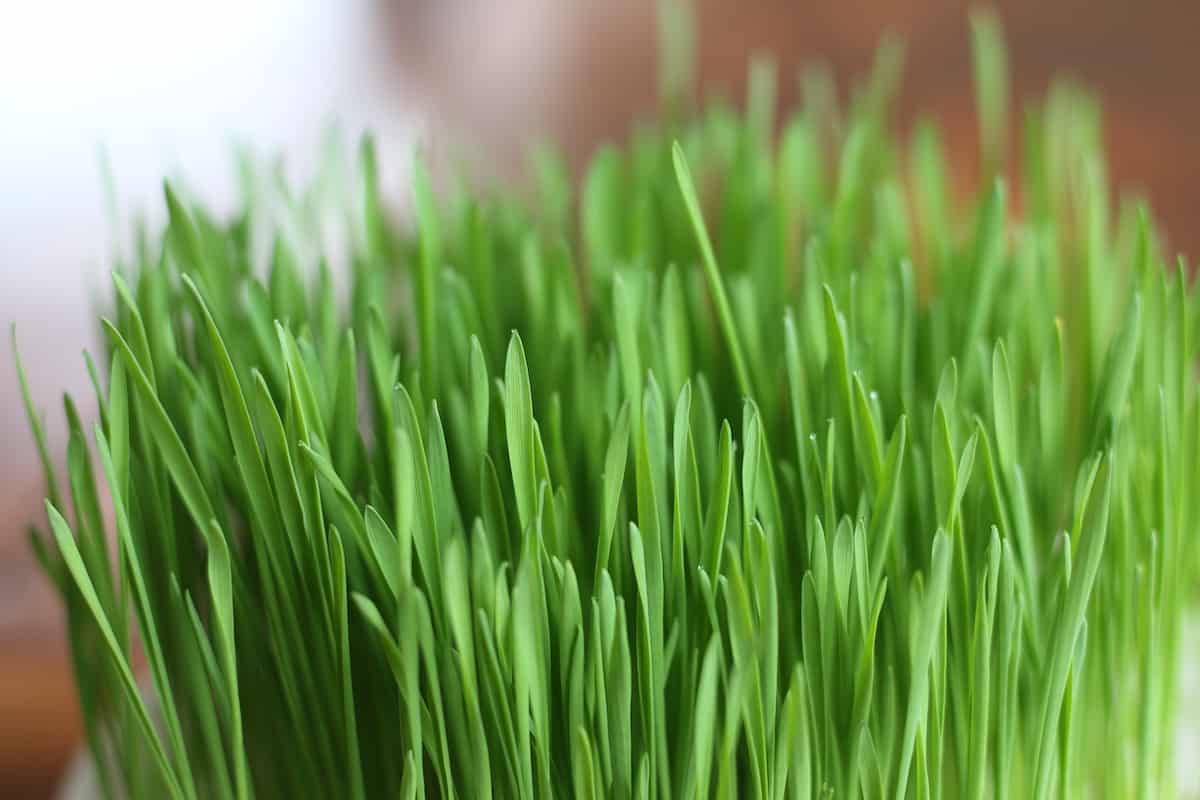
Why do cats eat grass?
Nibbling on grass is a natural behavior for cats. Cats supposedly eat grass to aid in digestion, as it can help with moving hairballs along. While it’s not integral to their diet, they may gain micronutrients or simply enjoy the sensation of nibbling.
If you have an outdoor cat, chances are that nibbling on grass is part of your kitty’s daily routine. But if your pet spends all of its time indoors (like most domestic cats), you may want to consider growing cat grass in your home.
Having organically-grown cat grass available to your pet is important when other sources of green plant matter are less than safe. Outdoor lawn grass is often fertilized with chemicals and treated with pesticides. Many indoor houseplants are toxic to cats. Simply having a tray of cat grass as an option for your cat may help them steer clear of these environmental toxins (and protect your precious plant babies from your precious fur baby)!
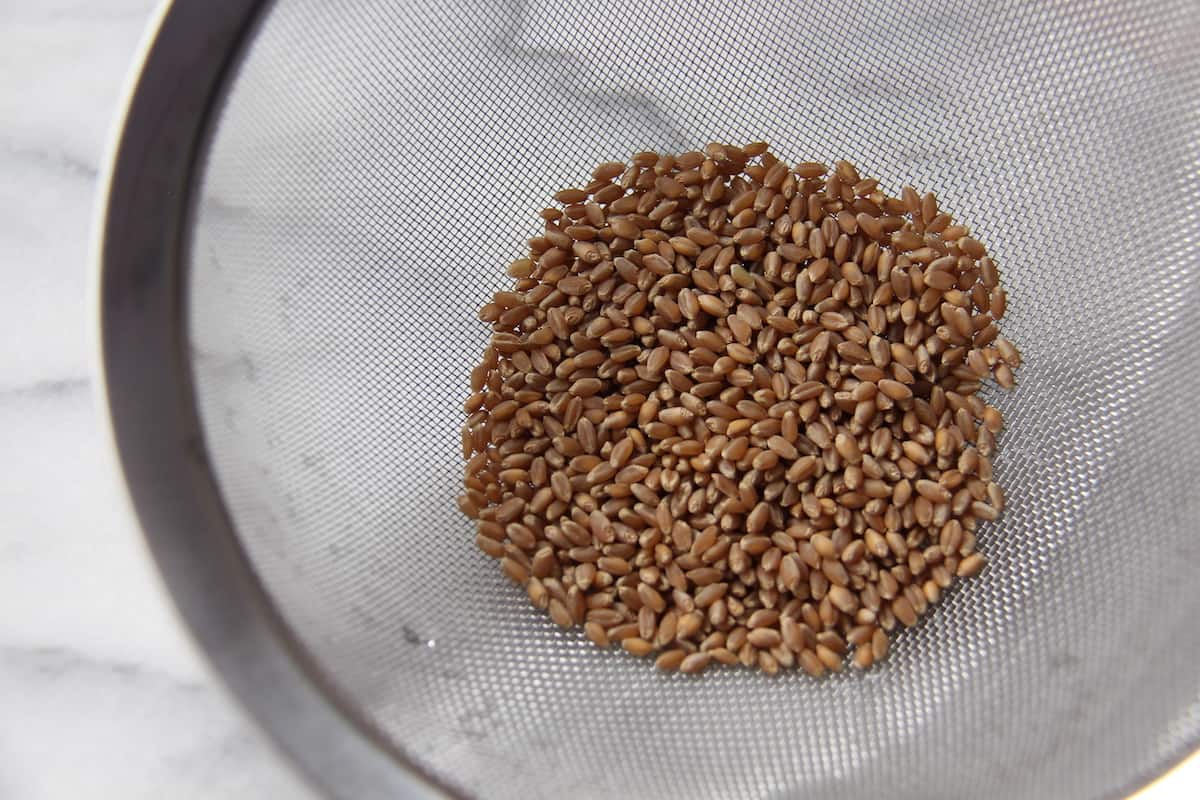
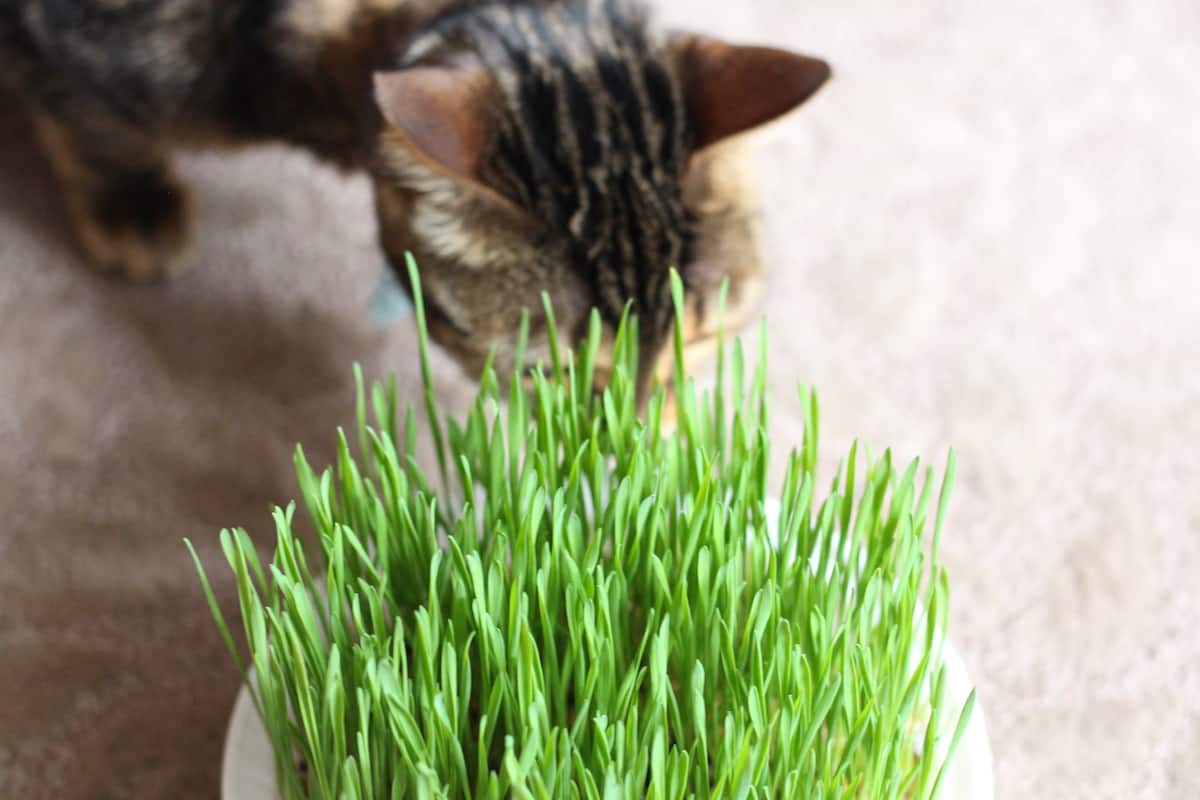
Growing cat grass without potting soil
One very common question about growing cat grass is whether or not potting soil is really required. It is completely possible to grow cat grass without potting soil, but the potting soil does make it easier. The potting soil acts as a moisture buffer so the seeds don’t dry out as quickly as they would if there were no soil. That said, if you keep the seeds moist, they will sprout up into cat grass without any soil at all.
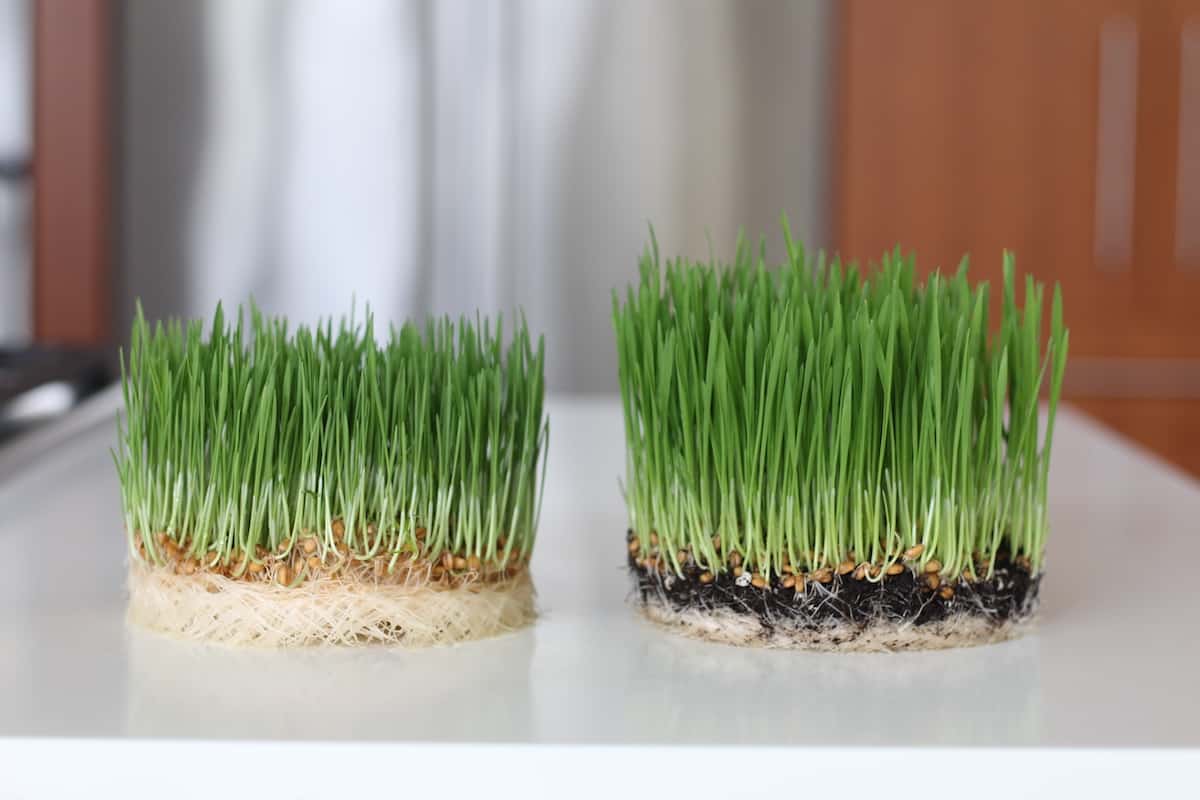
The photo above shows two trays of cat grass that were planted on the same day from the same batch of soaked wheat seeds – one without soil and one with potting soil.
The tray on the left, without soil, formed a ~1″-thick root layer below the seeds. While the blades of grass aren’t quite as long as the tray with soil, the resulting wheatgrass from the no-soil tray seems just fine. The trickiest part is keeping the seeds moist all week!
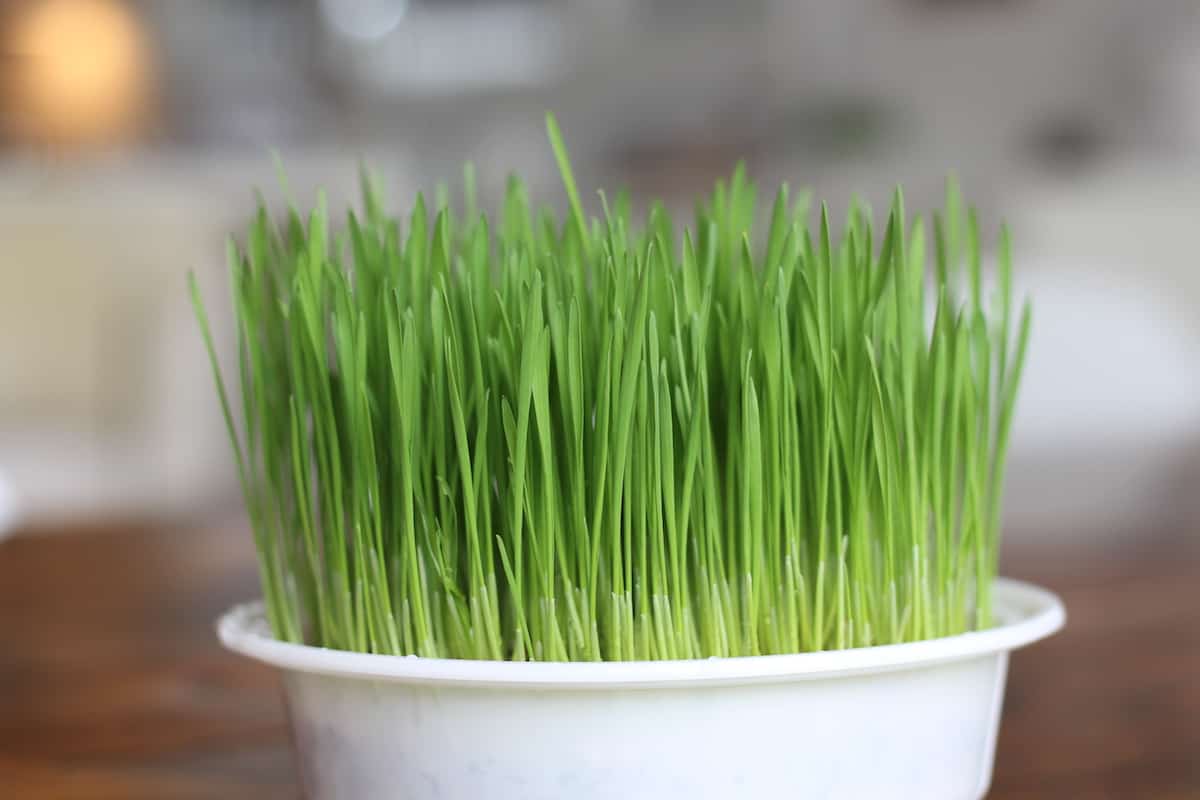
Is cat grass the same As Regular Lawn Grass?
Cat grass is not the same as a regular outdoor lawn grass. Cat grass is grown indoors from cereal grain seeds like oats, barley, wheat, and rye. Lawn grass is grown from grass species like fescue, bluegrass, zoysia, and Bermuda, which have been bred for ornamental value and durability underfoot.
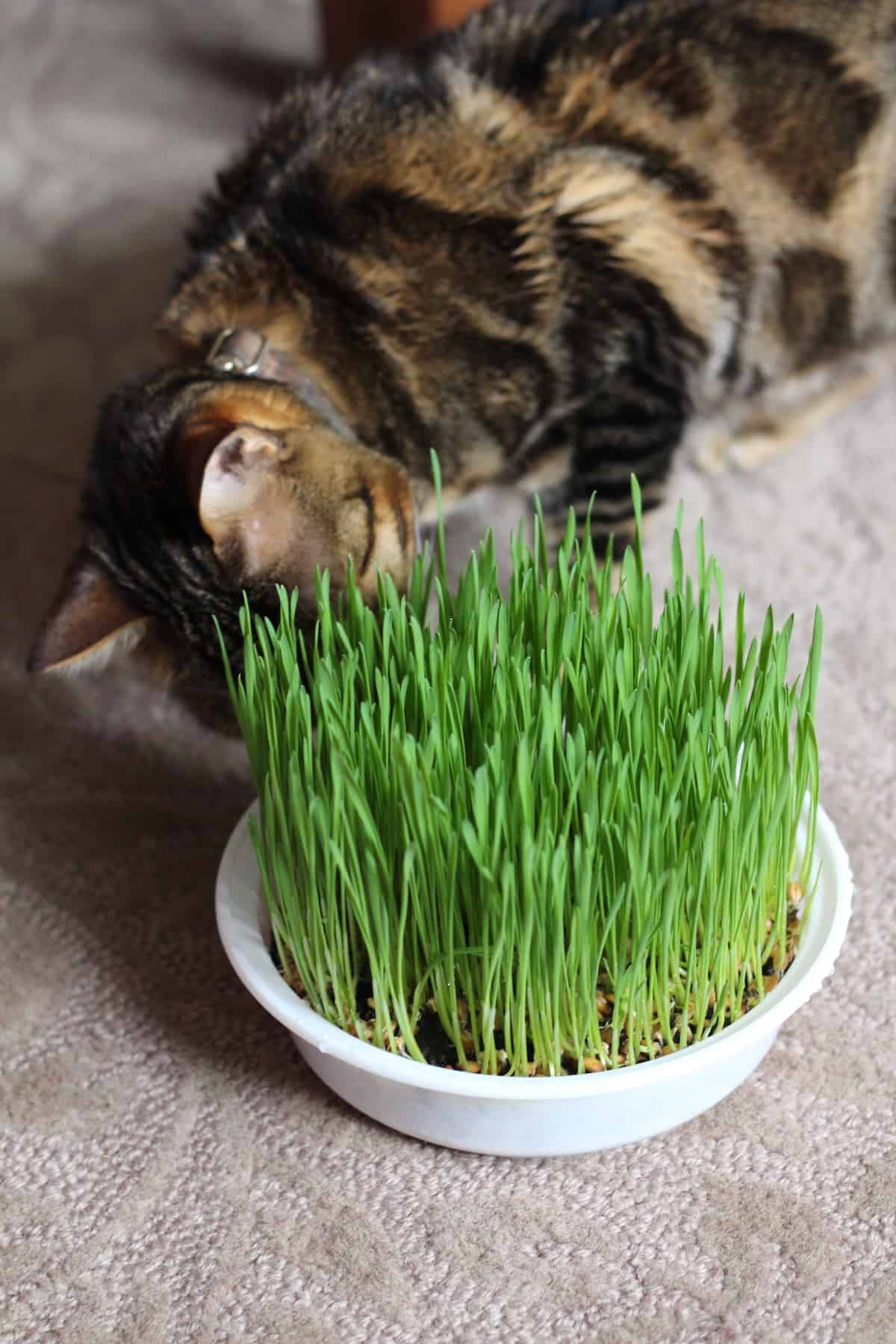
Is cat grass just wheat grass?
Wheatgrass is one variety of cat grass. Wheatgrass grown for humans could certainly be used instead as cat grass. Bulk wheatgrass seeds may be significantly cheaper than specialty “cat grass” seeds.
Cat grass can be grown from wheat seeds (just like wheatgrass), but it can also be grown from other cereal grains like oats, barley, and rye. Most commonly, cat grass is a mixture of grasses.
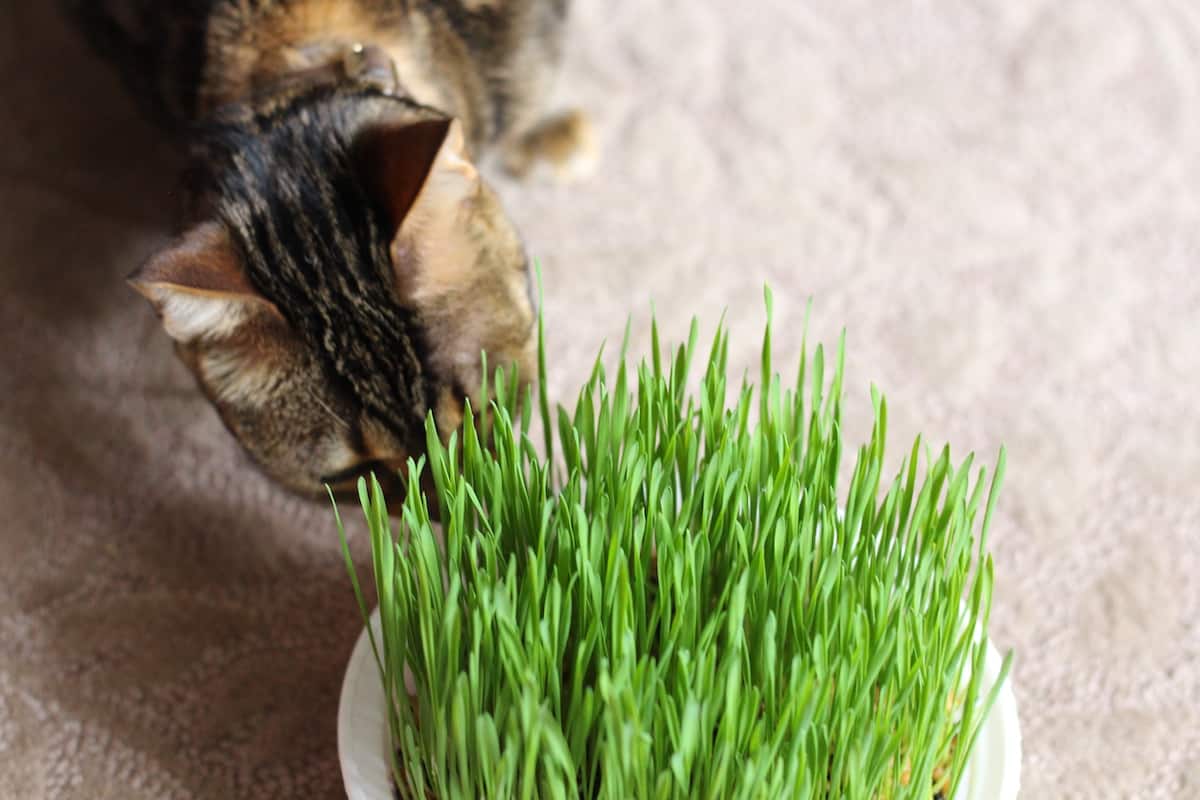
Is cat grass the same as catnip?
Cat grass is not the same as catnip.
Cat grass is grown from annual cereal grains like oats, wheat, barley, and rye. Catnip is a perennial herbaceous plant in the mint family. Cat grass tends to look like grass (see photo below), while catnip tends to look a lot like a leafy peppermint plant. A tray of cat grass rarely lasts more than a month, while catnip plants live for many years.
